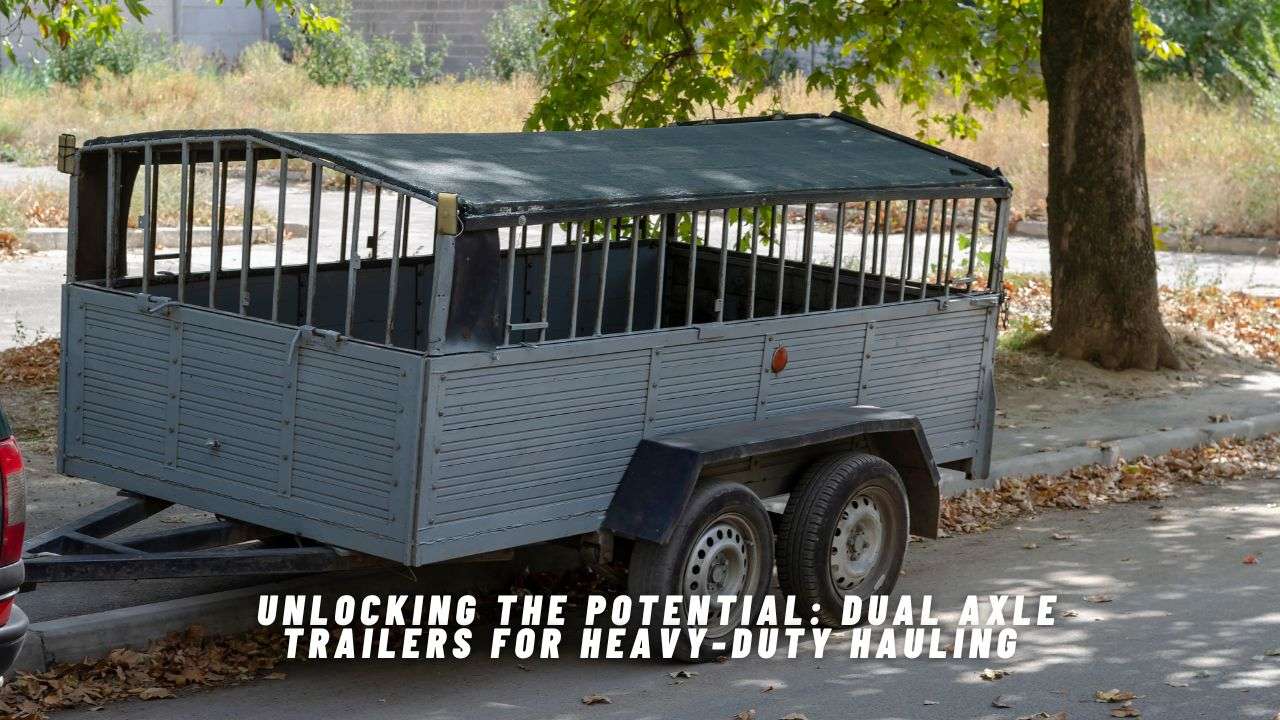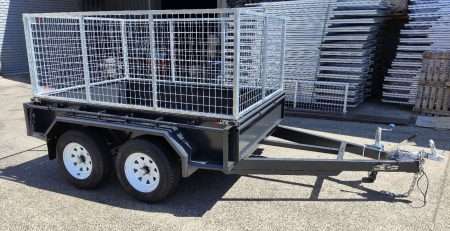
Unlocking the Potential: Dual Axle Trailers for Heavy-Duty Hauling
Understanding Dual Axle Trailers
When it comes to hauling heavy loads, dual-axle trailers are a popular choice due to their enhanced stability and weight-carrying capacity. In this section, we will explore what dual-axle trailers are and the benefits they offer.
What are dual-axis trailers?
Dual-axle trailers, also known as tandem-axle trailers, are trailers that feature two axles, each with its own set of wheels. These axles are positioned close together, typically with a small gap between them. The wheels on each axle work in unison to support the weight of the trailer and its cargo, providing improved weight distribution and stability.
The presence of two axles allows for better weight distribution and load-bearing capabilities, making dual-axle trailers ideal for hauling heavy loads over long distances. The wheels on each axle share the weight, reducing the strain on individual components and minimising the risk of tyre wear and other potential issues.
Benefits of Dual-Axle Trailers
Dual-axle trailers offer several benefits compared to single-axle trailers. Here are some key advantages:
Stability and weight distribution
One of the primary benefits of dual-axle trailers is their enhanced stability. With two axles supporting the weight, the trailer is less prone to swaying or fishtailing, providing a smoother towing experience. The weight distribution across the two axles also helps to maintain better balance, especially when carrying uneven or heavy loads.
Weight Capacity
Dual-axle trailers have a higher weight capacity compared to single-axle trailers. The additional axle and wheels allow for greater weight distribution, enabling the trailer to carry heavier loads without compromising safety. This makes dual-axle trailers suitable for hauling large equipment, construction materials, and other heavy items.
Safety and manoeuvrability
The presence of two axles provides improved braking capabilities, reducing the risk of accidents and enhancing overall towing safety. The dual-axle design helps to distribute the braking force across multiple wheels, resulting in more effective stopping power. This is particularly important when towing heavy loads or travelling on steep inclines.
Additionally, the extra set of wheels on dual-axle trailers enhances maneuverability. The additional tyres provide better traction, making it easier to navigate corners and turns. This can be especially beneficial when manoeuvring in tight spaces or challenging terrain.
Tyre wear and maintenance
Dual-axle trailers have better tyre wear due to the weight distribution across multiple wheels. The weight is spread out more evenly, resulting in reduced tyre wear and longer-lasting tires. This not only improves the longevity of the tyres but also reduces maintenance costs in the long run.
While dual axle trailers may come at a higher initial cost compared to single axle trailers, the added benefits in stability, weight capacity, safety, and reduced maintenance make them a worthwhile investment for those who frequently tow heavy loads or travel long distances.
Understanding the advantages of dual-axle trailers over single-axle trailers sets the foundation for comparing the two types further. In the next section, we will delve into the specific differences between dual-axle trailers and single-axle trailers, focusing on stability, weight capacity, and safety.
Dual-Axle Trailers vs. Single-Axle Trailers
When it comes to choosing a trailer for heavy-duty hauling, one important consideration is whether to opt for a dual-axle trailer or a single-axle trailer. Each type has its own advantages and limitations. In this section, we will explore the key differences between dual axle trailers and single axle trailers in terms of stability and weight distribution, weight capacity, safety, and manoeuvrability.
Stability and weight distribution
Dual-axle trailers offer better stability and weight distribution compared to single-axle trailers, making them more suitable for heavier loads and longer trips (source). With two axles, the weight of the load is distributed more evenly, reducing the strain on individual axles and tires. This balanced weight distribution helps to improve the overall stability of the trailer, enhancing control and reducing the risk of swaying or fishtailing while on the road.
Weight Capacity
One of the significant advantages of dual-axle trailers is their higher weight capacity compared to single-axle trailers. The presence of two axles allows dual-axle trailers to carry heavier loads without compromising safety (source). The additional support provided by the extra axle ensures that the weight is evenly distributed, reducing the strain on individual components and enhancing the trailer’s ability to handle heavier loads.
Safety and manoeuvrability
Dual-axle trailers provide improved braking capabilities, reducing the risk of accidents and improving overall towing safety (source). The additional set of brakes on the second axle helps to enhance stopping power, particularly when carrying heavier loads. This increased control over braking contributes to safer towing experiences.
In terms of manoeuvrability, single-axle trailers generally offer greater manoeuvrability compared to dual-axle trailers. Single-axle trailers are more agile and easier to manoeuvre in tight spaces or when making sharp turns. However, dual-axle trailers compensate for this limitation with their enhanced stability, weight capacity, and overall towing safety.
When deciding between a dual-axle trailer and a single-axle trailer, it’s important to consider the specific requirements of your hauling needs. Dual-axle trailers are well-suited for heavy loads and long-distance travel, offering superior stability, increased weight capacity, and enhanced safety. However, they may come at a higher price compared to single-axle trailers. Ultimately, the choice between the two depends on the nature of your hauling tasks and your budget.
Factors to Consider When Choosing a Dual-Axle Trailer
When selecting a dual-axle trailer for your hauling needs, there are several important factors to consider. These factors include towing laws and regulations, suspension systems, and hitching options. Understanding these aspects will help you make an informed decision and ensure that the trailer meets your specific requirements.
Towing Laws and Regulations
Before purchasing a dual-axle trailer, it is crucial to familiarise yourself with the towing laws and regulations in your state or region. Trailer towing laws can vary significantly, including maximum weight limits, braking system requirements, lighting specifications, safety chain guidelines, and more (World Population Review). Some states may also impose restrictions on maximum towing speeds, which can be as low as 25 miles per hour. Being aware of these regulations will help you choose a trailer that complies with the legal requirements and ensures a safe towing experience.
Suspension Systems
The suspension system of a dual-axle trailer plays a vital role in providing a smooth and stable ride while hauling heavy loads. There are different types of suspension systems available, including leaf spring suspension and torsion suspension. Leaf spring suspension consists of multiple layers of flexible metal strips, while torsion suspension utilises rubber cords to absorb shocks and vibrations.
Leaf spring suspension is commonly found in heavy-duty trailers and offers excellent load-carrying capabilities. It provides a traditional and reliable suspension system that can handle rough terrain and heavy loads. On the other hand, torsion suspension offers a smoother ride, better weight distribution, and improved handling. It is often preferred for trailers carrying fragile or delicate cargo.
When choosing a dual axle trailer, consider the suspension system that best suits your hauling needs, taking into account the load capacity, desired ride quality, and the type of terrain you will encounter.
Hitching Options
The hitching system is an essential component of a dual-axle trailer, as it connects the trailer to the towing vehicle. There are various hitching options available, including ball hitches, gooseneck hitches, and fifth-wheel hitches. Selecting the appropriate hitching option depends on the type of towing vehicle you have, the weight capacity of the trailer, and the intended use.
Ball hitches are the most common type of hitch and are suitable for smaller dual-axle trailers. They consist of a ball mounted on the rear of the towing vehicle, which connects to the trailer’s coupler. Gooseneck hitches are designed for larger trailers and provide improved stability and weight distribution by attaching to a hitch ball mounted in the bed of the towing vehicle. Fifth-wheel hitches are typically used for heavy-duty trailers and provide exceptional towing capacity and manoeuvrability.
When choosing a hitching option for your dual-axle trailer, ensure that it is compatible with your towing vehicle and meets the weight capacity requirements. It is also important to consider the ease of hitching and unhitching, as well as the overall towing experience.
Considering factors such as towing laws and regulations, suspension systems, and hitching options will guide you in selecting the right dual-axle trailer for your needs. By adhering to legal requirements and choosing a trailer with appropriate suspension and hitching features, you can ensure a safe and efficient hauling experience.
Maintenance and Care for Dual-Axle Trailers
To ensure optimal performance and safety on the road, dual-axle trailers require proper maintenance and regular inspection. By following these guidelines, you can extend the lifespan of your dual-axle trailer and prevent potential issues down the line.
Regular inspection and maintenance
Regular inspection is essential for identifying any signs of wear and tear as well as addressing them promptly. Here are some key components to inspect:
- Tyres: Check the tyre pressure, tread depth, and overall condition regularly. Replace any worn-out or damaged tyres as needed. Proper tyre care and replacement are crucial for maintaining stability and preventing blowouts.
- Suspension System: The suspension system of a dual-axle trailer is crucial for absorbing road shocks and vibrations, ensuring a smoother and more comfortable ride. Inspect the suspension components, such as leaf springs or torsion axles, for signs of damage or excessive wear. According to the manufacturer’s recommendations, lubricate moving parts.
- Brakes: If your dual-axle trailer is equipped with brakes, inspect the brake system regularly. Ensure that the brake pads are in good condition and that the braking mechanism functions properly. If you notice any issues with the brakes, have them repaired or replaced by a qualified professional.
- Lights and Electrical System: Check all lights, including brake lights, turn signals, and taillights, to ensure they are functioning correctly. Inspect the electrical connections and wiring for any signs of damage or corrosion. Repair or replace any faulty components immediately.
Tyre Care and Replacement
Proper tyre care is crucial for the safe towing and longevity of your dual-axle trailer. Follow these guidelines:
- Maintain the recommended tire pressure as set forth by the manufacturer. Underinflated or overinflated tyres can affect stability, fuel efficiency, and tyre lifespan.
- Tread Depth: Regularly check the tread depth of your trailer tires. Adequate tread depth ensures proper traction and helps prevent hydroplaning. Replace tyres that have worn down to the minimum recommended tread depth.
- Rotation: Consider rotating the trailer tyres regularly to promote even wear. This is especially important if your trailer carries heavy loads, as it can cause uneven tyre wear.
- Spare Tyre: Always carry a properly inflated spare tyre that is in good condition. In the event of a tyre failure, having a spare tyre readily available can save you from being stranded.
Proper weight distribution
Proper weight distribution is critical for safe and efficient towing. Dual-axle trailers excel in this aspect by evenly distributing the load’s weight. By following these guidelines, you can achieve optimal weight distribution:
- Load Distribution: Distribute the load evenly across the trailer, placing heavier items closer to the trailer’s centre of gravity. This helps maintain stability and prevents excessive strain on a single axle.
- Tongue Weight: Ensure that the tongue weight, or the downward force the trailer coupler applies to the hitch ball, is within the recommended range. Proper tongue weight helps maintain control and stability during towing.
- Balance: Check the trailer’s balance by using a tongue weight scale or consulting the manufacturer’s guidelines. Adjust the load as necessary to achieve the recommended balance.
- Hitching Options: Dual-axle trailers offer various hitching options, making them adaptable to different towing vehicles and applications. They can accommodate a ball hitch, gooseneck, or fifth-wheel hitch, depending on specific needs.
By following these maintenance and care practices, you can keep your dual-axle trailer in excellent condition and ensure safe and efficient hauling. Regular inspections, proper tyre care, and attention to weight distribution will help maximise the lifespan of your trailer and enhance your towing experience.
Applications and Industries for Dual-Axle Trailers
Dual-axle trailers have become an indispensable tool in various industries, thanks to their ability to transport heavy loads efficiently and safely. Let’s explore two key applications where dual axle trailers excel: heavy load hauling and versatility and adaptability.
Heavy Load Hauling
The primary advantage of dual-axle trailers is their capability to handle heavy loads with ease. The additional set of wheels and axles provides increased stability and weight distribution, making them ideal for transporting substantial loads. Compared to single-axle trailers, dual-axle trailers have a higher towing capacity, allowing them to carry heavier loads without compromising safety (Source).
The stability of dual-axle trailers plays a crucial role in heavy-load hauling. The weight of the load is distributed more evenly across the four wheels, reducing the risk of tipping or swaying, especially when navigating uneven terrain or making sharp turns. This enhanced stability ensures that the load remains secure during transportation, providing peace of mind to operators and preventing potential accidents (source).
Versatility and adaptability
Dual-axle trailers offer exceptional versatility and adaptability, making them suitable for a wide range of applications. They can be customised to meet specific requirements, catering to various industries such as construction, agriculture, landscaping, and more. The adaptability of dual-axle trailers is attributed to their hitching options. They can accommodate different types of hitches, including ball hitches, goosenecks, and fifth-wheel hitches, depending on the specific needs of the towing vehicle and application (Source).
Dual-axle trailers are available in different sizes and configurations, allowing for customisation based on the type of cargo being transported. Whether it’s tandem utility trailers, tandem boat trailers, tandem dump trailers, tandem flatbed trailers, tandem enclosed trailers, or any other variation, there is a dual axle trailer to suit the specific needs of each industry (Source).
In addition to their adaptability, dual-axle trailers excel in proper weight distribution. By evenly distributing the load’s weight, dual-axle trailers prevent overloading on a single axle. This not only enhances safety but also minimises wear and tear on tyres and suspension components, prolonging the trailer’s lifespan. Proper weight distribution is critical for safe and efficient towing, and dual-axle trailers excel in this aspect (Source).
Dual-axle trailers are designed to handle heavy loads while providing stability, adaptability, and proper weight distribution. These qualities make them a popular choice across various industries for transporting cargo efficiently and safely. Whether it’s heavy load hauling or the need for a versatile and adaptable solution, dual-axle trailers are a reliable option for businesses and individuals alike.
Exploring Dual Axle Trailers
When it comes to heavy-duty hauling, dual-axle trailers offer unmatched stability, weight distribution, and load capacity. Let’s take a closer look at the benefits and features of dual-axle trailers.
What are dual-axis trailers?
Dual-axle trailers, also known as tandem trailers, are trailers equipped with two axles instead of one. Each axle has a set of wheels, allowing for better weight distribution and increased load capacity. The two axles are typically positioned close together, providing improved stability during towing.
Benefits of Dual-Axle Trailers
Dual-axle trailers offer several advantages over their single-axle counterparts. Here are some key benefits:
- Stability and Weight Distribution:
Dual-axle trailers provide better stability and weight distribution compared to single-axle trailers, making them ideal for towing heavier loads and longer distances (Big Tex Trailer World). The weight of the load is distributed across two axles, reducing the chances of swaying or fishtailing. - Weight Capacity:
Dual-axle trailers have a higher load capacity than single-axle trailers, allowing them to carry heavier loads (Big Tex Trailer World). The additional axle provides extra support and distributes the weight evenly, ensuring the safe and efficient transport of heavy cargo. - Safety and Manoeuvrability:
Dual-axle trailers are less prone to swaying or fishtailing while towing, providing a smoother and safer towing experience. The added stability makes it easier to navigate sharp turns and manoeuvre through challenging terrain. - Reduced risk of tyre blowouts:
Dual-axle trailers have a lower risk of tyre blowouts compared to single-axle trailers because the weight is distributed across more tyres (Big Tex Trailer World). This reduces the strain on individual tyres and minimises the chances of tyre failure during long journeys. - Durability and longevity:
Dual-axle trailers are designed to withstand heavy loads and extended use. The additional axle and reinforced construction ensure durability and longevity, making them suitable for demanding hauling tasks.
While dual-axle trailers offer numerous benefits, it’s important to note that they are generally more expensive than single-axle trailers due to the additional materials and construction required for the second axle (Big Tex Trailer World). However, the enhanced performance and increased load capacity make them a worthwhile investment for heavy-duty hauling needs.
When selecting a dual-axle trailer, consider factors such as towing laws and regulations, suspension systems, and hitching options. Regular maintenance and care, such as inspecting and maintaining the trailer, ensuring proper tyre care, and maintaining proper weight distribution, are essential to maximising the lifespan and performance of dual axle trailers.
Dual-axle trailers find applications in various industries, including heavy-load hauling, construction, agriculture, and more. Their versatility and adaptability make them a reliable choice for transporting a wide range of goods and equipment.
By choosing a dual-axle trailer, you can confidently tackle heavy-duty hauling tasks, knowing that you have a reliable and stable platform to transport your valuable cargo.
Author
I am Rahatul Ashiq Tamal. Another author of Muscle Trailers. Muscle Trailers is a well-known trailer brand in Sydney, Melbourne & Adelaide

How to Mount a Spare Tire on Your Trailer: A Simple Step-by-Step Guide
Trailer service centers receive over 1 million phone calls and 1.3 million emails each year about trailer maintenance problems....

How to Fix RV Roof Leaks: Simple Roof Leak Detection Guide for Beginners
Did you know DIY RV roof repairs can cost under $50? But undetected leaks could lead to substantially higher repair...

Starting a Food Truck Business in Australia: From Trailer Selection to Launch
The Australian mobile food market has evolved into a billion-dollar industry. This makes a food truck...
